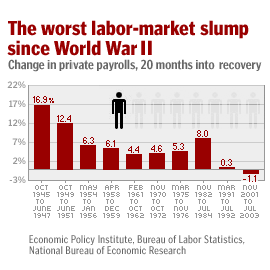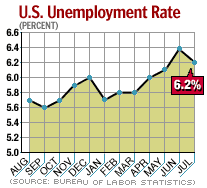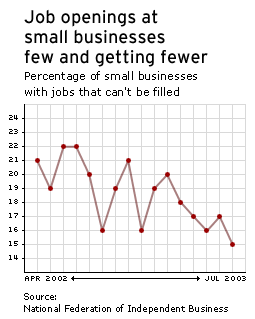NEW YORK (CNN/Money) -
By most lights the economy has recovered smartly from this spring's downturn, but every bit of good news that crosses the wire these days is probably met with a resounding "So what?" from the 9 million Americans without jobs.
Unfortunately, despite the pickup in economic growth, those who are unemployed aren't going to see many new jobs any time soon, according to many economists.

Thursday's data were the latest in a trend -- the Commerce Department said gross domestic product (GDP), the broadest gauge of economic health, grew at a 3.1 percent annual rate in the second quarter, faster than expected, even as the Labor Department reported a slight rise in weekly unemployment claims.
"Despite the healthier economic outlook, the Achilles heel of the economy is a lack of jobs," said Sung Won Sohn, chief economist at Wells Fargo & Co.
Most economists think GDP growth will accelerate in the second half of 2003, approaching 5 percent, according to some forecasts, before settling into a cruising speed of about 3.7 percent in 2004, according to the average forecasts of 30 economists surveyed by the Philadelphia Federal Reserve.

In most recoveries, such growth spurs job creation. But it doesn't just happen overnight, since companies first must become confident of the recovery, then take time to seek and interview job applicants.
Bank One senior economist Peter Glassman said he expects job creation in "the next several quarters," but he echoed the Philly Fed's consensus estimate that the unemployment rate would average 5.9 percent in 2004, only slightly lower than July's rate of 6.2 percent.
"We don't think the unemployment rate will be any lower than 5.5 percent by the 2004 election," Glassman said.
Signs hopeful, not so hopeful
Still, there have been good signs for the job market of late, most notably the fact that weekly jobless claims in five of the past six weeks have been below 400,000, the usual benchmark for labor-market weakness.
But claims haven't been that far below 400,000 -- the most recent four-week average is 396,250 -- and they've been skewed in July and much of August by summer shutdowns in the automobile and other industries.

"[The] jobless claims report indicates we still aren't seeing much evidence that the jobs picture is brightening," said Bill Cheney, chief economist at John Hancock Financial Services in Boston.
Meanwhile, small businesses, often the first to hire in a job market rebound, still have little room for new workers, according to a recent survey of 1,160 businesses by the National Federation of Independent Business. Even after cutting their payrolls in 28 of the past 30 months, only 15 percent of small firms said they had jobs that were hard to fill, the lowest percentage since 1993.
The good news is that bigger businesses have added 122,000 temporary workers in the past three months, the strongest such period since the Labor Department started keeping track in 1990. Companies often use temps to meet increased demand in an upturn, just before they hire permanent workers again.
But Scott Brown, chief economist at Raymond James & Associates, said in a recent research note that companies could be hiring temps just to avoid rising health-care costs.
What's more, employers have learned to squeeze more work out of fewer workers. Productivity, the measure of output per worker hour, grew in 2002 at the fastest pace since 1950.
"With such rapid gains in productivity, GDP growth may need to be 4 percent or so to be consistent with even moderate job growth," Brown told CNN/Money.
Economy shifts gears
And some of the jobs lost in recent years have gone to places such as China, India and the Philippines, where labor and benefit costs are cheaper. This is an old story for manufacturing, but now other industries -- including services such as health care, architecture and accounting -- also are jumping ship.
| Related stories
|

|
|
|
|
Still, manufacturing has borne the brunt of the labor market pain, losing 2.3 million of the 2.7 million total jobs lost since March 2001. Many of those jobs are unlikely to return as the U.S. economy shifts further from manufacturing to services, forcing many workers to seek greener pastures.
"The manufacturing sector will continue to shed jobs for the foreseeable future," Wachovia Securities analyst Matthew Ellis wrote in a recent research note, citing a "structural change, not just a cyclical downturn" in the industry.
Ellis's sentiment was echoed by a New York Fed study this week pointing to structural causes of the long "jobless" recovery from the 2001 recession.
"Industries that lost jobs during the recession have continued to shrink during the recovery, and permanent job losses have eclipsed temporary layoffs," Fed economists Erica Groshen and Simon Potter wrote.
Broader economy at risk?
Many analysts worry the labor market's pain threatens the broader economy, since it may cause consumers to curb their spending, which fuels two-thirds of the world's largest economy.
But it takes an awful lot to keep consumers from spending. Despite a recession, terrorist attacks, a three-year bear market in stocks, corporate scandals and two wars, they still have managed to keep it together long enough to buy new cars, houses and TVs.
Rather than a consumer-driven recession, many economists think the most likely scenario is more of the same -- a stop-and-start economy with a labor market that's not bleeding jobs, but is still a long way from total health.
"The economy has been so resilient to all these shocks, we would have to have widespread job loss to get a recession, and I don't see that happening," said Richard Yamarone, chief economist at Argus Research. "But I think we will have a trickling of jobs in and out. That could lead to weaker economic growth than we anticipate."

|

